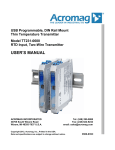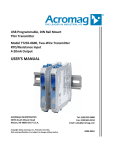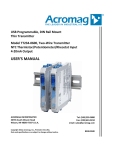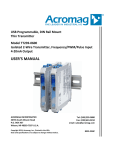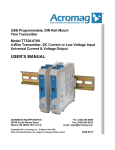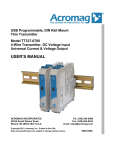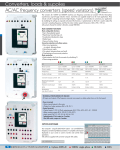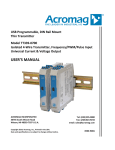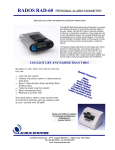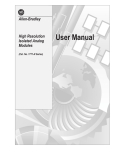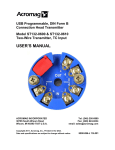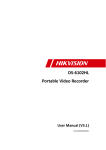Download 8500940C TT236-0600 User`s Manual
Transcript
USB Programmable, DIN Rail Mount Thin Transmitter Model TT236-0600, Two-Wire Transmitter, DC Current or Low DC Voltage Input USER’S MANUAL ACROMAG INCORPORATED 30765 South Wixom Road Wixom, MI 48393-7037 U.S.A. Tel: (248) 295-0880 Fax: (248) 624-9234 email: [email protected] Copyright 2012-2013, Acromag, Inc., Printed in the USA. Data and specifications are subject to change without notice. 8500-940C Model TT236-0600 Two-Wire DC I/V Transmitter w/USB Table of Contents GETTING STARTED DESCRIPTION ....................................................................................................... 5 Key Features ........................................................................................................................5 Application ..........................................................................................................................5 Mechanical Dimensions .......................................................................................................7 DIN Rail Mounting & Removal ..............................................................................................7 ELECTRICAL CONNECTIONS ............................................................................ 8 Input Connections................................................................................................................9 Output/Power Connections ............................................................................................... 10 Earth Ground Connections ................................................................................................. 12 USB Connections................................................................................................................ 13 CONFIGURATION SOFTWARE ...................................................................... 14 Quick Overview ................................................................................................................. 14 TECHNICAL REFERENCE OPERATION STEP-BY-STEP .......................................................................... 16 Connections....................................................................................................................... 16 Configuration..................................................................................................................... 17 Calibration (Optional) ........................................................................................................ 20 BLOCK DIAGRAM ............................................................................................. 22 How It Works ..................................................................................................................... 22 TROUBLESHOOTING ....................................................................................... 23 Diagnostics Table ............................................................................................................... 23 Service & Repair Assistance ............................................................................................... 25 Acromag, Inc. Tel: 248-295-0880 -2--2- http://www.acromag.com http://www.acromag.com Model TT236-0600 Two-Wire DC I/V Transmitter w/USB ACCESSORIES .................................................................................................... 26 Software Interface Package................................................................................................ 26 USB Isolator ....................................................................................................................... 26 USB A-B Cable .................................................................................................................... 26 USB A-mini B Cable ............................................................................................................ 26 SPECIFICATIONS .............................................................................................. 27 Model Number .................................................................................................................. 27 Input ................................................................................................................................. 27 Output............................................................................................................................... 29 USB Interface ..................................................................................................................... 30 Enclosure & Physical .......................................................................................................... 31 Environmental ................................................................................................................... 31 Agency Approvals .............................................................................................................. 32 Reliability Prediction .......................................................................................................... 32 Configuration Controls ....................................................................................................... 33 DESCRIPTION ....................................................................................................... 5 Key Features ........................................................................................................................5 Application ..........................................................................................................................5 Mechanical Dimensions .......................................................................................................7 DIN Rail Mounting & Removal ..............................................................................................7 ELECTRICAL CONNECTIONS ............................................................................ 8 Input Connections................................................................................................................9 Output/Power Connections ............................................................................................... 10 Earth Ground Connections ................................................................................................. 12 USB Connections................................................................................................................ 13 CONFIGURATION SOFTWARE ...................................................................... 14 Quick Overview ................................................................................................................. 14 OPERATION STEP-BY-STEP .......................................................................... 16 Acromag, Inc. Tel: 248-295-0880 -3--3- http://www.acromag.com http://www.acromag.com Model TT236-0600 Two-Wire DC I/V Transmitter w/USB Connections....................................................................................................................... 16 Configuration..................................................................................................................... 17 Calibration (Optional) ........................................................................................................ 20 BLOCK DIAGRAM ............................................................................................. 22 How It Works ..................................................................................................................... 22 TROUBLESHOOTING ....................................................................................... 23 Diagnostics Table ............................................................................................................... 23 Service & Repair Assistance ............................................................................................... 25 ACCESSORIES .................................................................................................... 26 Software Interface Package................................................................................................ 26 USB Isolator ....................................................................................................................... 26 USB A-B Cable .................................................................................................................... 26 USB A-mini B Cable ............................................................................................................ 26 SPECIFICATIONS .............................................................................................. 27 Model Number .................................................................................................................. 27 Input ................................................................................................................................. 27 Output............................................................................................................................... 29 USB Interface ..................................................................................................................... 30 Enclosure & Physical .......................................................................................................... 31 Environmental ................................................................................................................... 31 Agency Approvals .............................................................................................................. 32 Reliability Prediction .......................................................................................................... 32 Configuration Controls ....................................................................................................... 33 REVISION HISTORY ......................................................................................... 34 All trademarks are the property of their respective owners. Acromag, Inc. Tel: 248-295-0880 -4--4- http://www.acromag.com http://www.acromag.com Model TT236-0600 Two-Wire DC I/V Transmitter w/USB IMPORTANT SAFETY CONSIDERATIONS You must consider the possible negative effects of power, wiring, component, sensor, or software failure in the design of any type of control or monitoring system. This is very important where property loss or human life is involved. It is important that you perform satisfactory overall system design and it is agreed between you and Acromag, that this is your responsibility. The information of this manual may change without notice. Acromag makes no warranty of any kind with regard to this material, including, but not limited to, the implied warranties of merchantability and fitness for a particular purpose. Further, Acromag assumes no responsibility for any errors that may appear in this manual and makes no commitment to update, or keep current, the information contained in this manual. No part of this manual may be copied or reproduced in any form without the prior written consent of Acromag, Inc. GETTING STARTED DESCRIPTION Symbols on equipment: ! Means “Refer to User’s Manual (this manual) for additional information” The TT236-06x0 is an ANSI/ISA Type II transmitter designed to interface with DC Current (0-20mA/4-20mA), or Low Voltage DC (±0.5V/0-500mV) sensors, isolate the input signal, and modulate a 4-20mA current signal to drive a two-wire current loop. This unit is setup and calibrated using configuration software and a USB connection to Windows-based PC’s (Windows XP and later versions only). The unit provides an adjustable input range, input isolation, and variable input filtering. Key Features Digitally setup and calibrated w/ Windows software via USB. Thin 12.5mm wide enclosure for high-density DIN-rail mounting. Supports both process current input and DC voltage input on same model. DC Current Input 1 for 0-20mA, 4-20mA, 0-11.17mA, and ±1mA. DC Voltage Input 2 for ±0.5V and 0-500mV. High measurement accuracy and linearity with 16-bit conversion. Adjustable input ranges. Extra output connections support optional sourced output wiring. Variable Input Filter Adjustment. Normal or Reverse Acting output. Convenient two-wire loop power with non-polarized output connections. Namur compliant loop current. Wide ambient temperature operation. Thoroughly Tested and Hardened For Harsh Environments. CE Approved. Includes UL/cUL Class 1, Division 2 Approvals. Application For additional information on This transmitter is designed for high-density mounting on T-type DIN rails. Units may be mounted side-by-side on 12.5mm centers. Acromag, Inc. Tel: 248-295-0880 -5--5- http://www.acromag.com http://www.acromag.com Model TT236-0600 these devices and related topics, please visit our web site at www.acromag.com and download our whitepaper 8500-904, Introduction to Two-Wire Transmitters. Two-Wire DC I/V Transmitter w/USB This model isolates a current or voltage input signal and can mate with grounded or non-grounded sensors. It provides a 4-20mA output current linear with sensor current or voltage. The output signal is transmitted via a two-wire, 4-20mA current loop. The two-wire current signal can be transmitted over long distances with high noise immunity. Its inherent live-zero 4mA offset current offers built-in output fault detection, should an output wire break. Extra connection screws at the output allow it to be optionally wired for a “sourced” 4-20mA output configuration (see Optional Output Wiring). Acromag, Inc. Tel: 248-295-0880 -6--6- http://www.acromag.com http://www.acromag.com Model TT236-0600 Two-Wire DC I/V Transmitter w/USB Mechanical Dimensions 99.0 (3.90) Units may be mounted to 35mm “T” type DIN rail (35mm, type EN50022), and side-by-side on 0.5inch centers. WARNING: IEC Safety Standards may require that this device be mounted within an approved metal enclosure or sub-system, particularly for applications with exposure to voltages greater than or equal to 75VDC or 50VAC. 12.5 (0.50) 114.5 (4.51) DIMENSIONS ARE IN MILLIMETERS (INCHES) DIN Rail Mounting & Removal Refer to the following figure for attaching and removing a unit from the DIN rail. A spring loaded DIN clip is located on the input side bottom. The opposite rounded edge at the bottom of the output side allows you to tilt the unit upward to lift it from the rail while prying the spring clip back with a screwdriver. To attach the module to T-type DIN rail, angle the top of the unit towards the rail and place the top groove of the module over the upper lip of the DIN rail. Firmly push the unit downward towards the rail until it snaps into place. To remove it from the DIN rail, first separate the input terminal blocks from the bottom side of the module to create a clearance to the DIN mounting area. You can use a screwdriver to pry the pluggable terminals out of their sockets. Next, while holding the module in place from above, insert a screwdriver into the lower path of the bottom of the module to the DIN rail clip and use it as a lever to force the DIN rail spring clip down while pulling the bottom of the module outward until it disengages from the rail. Then simply lift it from the rail. Acromag, Inc. Tel: 248-295-0880 -7--7- http://www.acromag.com http://www.acromag.com Model TT236-0600 Two-Wire DC I/V Transmitter w/USB TT2XX MODULE DIN RAIL MOUNTING AND REMOVAL (OUTPUT SIDE) TOP TILT MODULE UPWARD TOWARDS RAIL AND HOOK ONTO UPPER LIP OF RAIL. ROTATE MODULE DOWNWARD TO ENGAGE SPRING CLIP ONTO LOWER LIP OF RAIL. 35mm DIN Rail TT2XX MODULE T-Rail SPRING CLIP BOTTOM (INPUT SIDE) SCREWDRIVER SLOT FOR REMOVAL FROM "T" TYPE DIN RAIL USE SCREWDRIVER TO REMOVE MODULE FROM RAIL AS SHOWN ELECTRICAL CONNECTIONS ! WARNING – EXPLOSION HAZARD – Do not disconnect equipment unless power has been removed or the area is known to be non-hazardous. WARNING – EXPLOSION HAZARD – Substitution of any components may impair suitability for Class I, Division 2. WARNING – EXPLOSION HAZARD – The area must be known to be non-hazardous before servicing/replacing the unit and before installing. Wire terminals can accommodate 14-26 AWG solid or stranded wire. Input wiring may be shielded or unshielded type. Ideally, output wires should be twisted pair. Terminals are pluggable and can be removed from their sockets by prying outward from the top with a flat-head screwdriver blade. This model allows current input to be wired to TB1, and voltage input to TB2, but only one input may drive the current output. Strip back wire insulation 0.25-inch on each lead and insert the wire ends into the cage clamp connector of the terminal block. Use a screwdriver to tighten the screw by turning it in a clockwise direction to secure the wire (0.5-0.6Nm torque). Since common mode voltages can exist on signal wiring, adequate wire insulation should be used and proper wiring practices followed. As a rule, output wires are normally separated from input wiring for safety, as well as for low noise pickup. Acromag, Inc. Tel: 248-295-0880 -8--8- http://www.acromag.com http://www.acromag.com Model TT236-0600 Two-Wire DC I/V Transmitter w/USB Input Connections Sensor wires are wired directly to transmitter input terminals at the bottom of the module (the spring-loaded DIN clip side), as shown in the connection drawing below. Observe proper polarity when making input connections. Transmitter input signal is isolated from output. DC Current is wired to the upper terminal blocks (TB1). DC Voltage is wired to the lower terminal blocks (TB2). Inputs are polarized “+” and “-“. The positive input is on the left and labeled “+”, and the negative input is to its right. Observe proper polarity. See connection figure below. Only one input, current or voltage, may drive the output at one time. MODEL TT236-0600 INPUT SENSOR WIRING BOTTOM VIEW (INPUT SIDE) 1 SHIELDED CABLE 1 + DC CURRENT (mA) 2 OPT SHLD GND + SHIELDED CABLE - I DC CURRENT 3 DC VOLTAGE 3 DC VOLTAGE V (Volts) - OUTPUT SIDE 2 4 + - WIRE VOLTAGE TO TB2 + - FRONT TB1 INPUT TERMINALS WIRE CURRENT TO TB1 INPUT SIDE TB1 DC CURRENT ONLY TB2 INPUT TERMINALS MODEL TT236-0600 TB2 DC VOLTAGE ONLY + V 4 - OPT SHLD GND (2-WIRE ONLY) INPUTS ARE ISOLATED FROM THE OUTPUT. INPUTS SHARE COMMON AND ARE NOT ISOLATED FROM EACH OTHER. ONLY ONE INPUT, CURRENT OR VOLTAGE, MAY DRIVE THE OUTPUT AT ONE TIME. DIN RAIL SPRING CLIP DIN RAIL SPRING CLIP Acromag, Inc. Tel: 248-295-0880 -9--9- http://www.acromag.com http://www.acromag.com Model TT236-0600 Two-Wire DC I/V Transmitter w/USB Output/Power Connections This transmitter has an ANSI/ISA Type 2 output in which the unit’s power and output signal share the same two leads, and the transmitter output has a “floating” connection with respect to earth ground. Connect a DC power supply and load in series in the two-wire loop as shown in the drawing below. Output connections are not polarized. The output + and – designations are for reference only with current normally input to Output+ and returned via Output(current sinking). Loop supply voltage should be from 12-32V DC with the minimum voltage level adjusted to supply over-range current to the load, plus 11V MIN across the transmitter, plus any transmission line drop. Variation in power supply voltage between the minimum required, and 32V maximum, has negligible effect on transmitter accuracy. Variation in load resistance has negligible effect on output accuracy, as long as the loop supply voltage is set accordingly. Note the traditional placement of earth ground in the current loop. The transmitter output varies off this ground by the voltage drop in the load resistance and lead-wire. MODEL TT2XX-0600 OUTPUT/POWER WIRING TRADITIONAL LOOP-POWERED "SINKING OUTPUT" CONNECTIONS INPUT SIDE TOP VIEW (OUTPUT SIDE) OUTPUT SIDE THIS TRANSMITTER IS CURRENT LOOP POWERED TB3 TB3 OUTPUT TERMINALS (UPPER LEVEL) I 5 6 - + 5 - TB4 MODEL TT2XX-0600 + 6 7 8 7 8 C C OPT "C" TERMINALS ARE COMMON (SEE OPT TB4 WIRING) 4-20mA SHIELDED TWISTED PAIR + - + - I I + R LOAD DC SUPPLY (12-32V) EARTH GROUND NOTE: OUTPUT TERMINALS ARE NOT POLARIZED AND PLUS & MINUS LABELS ARE FOR REFERENCE ONLY. OPTIONAL WIRING TERMINALS C ARE HELD IN COMMON AND USED FOR "SOURCING" LOOP WIRING. SEE OPTIONAL OUTPUT WIRING DIAGRAM. The traditional loop-powered “sinking” output connections are shown above. Shielded twisted-pair wiring is often used at the output to connect the longest distance between the field transmitter and the remote receiver as shown. The output of this transmitter fluctuates relative to earth ground by the voltage drop in the load and connection wire. This makes it flexible in the way it connects to various “Receiver” devices. Acromag, Inc. Tel: 248-295-0880 - 10 -- 10 - http://www.acromag.com http://www.acromag.com Model TT236-0600 Two-Wire DC I/V Transmitter w/USB In most installations, the loop power supply will be local to either the transmitter, or local to the remote receiver. Common receiver devices include the input channel of a Programmable Logic Controller (PLC), a Distributed Control System (DCS), or a panel meter. Some receivers already provide excitation for the transmitter loop and these are referred to as “sourcing inputs”. Other receivers that do not provide the excitation are referred to as “sinking” inputs, and these will require that a separate power supply connect within the loop. These types of receivers are depicted below: Output/Power Connections… MODEL TT2XX-0600 OUTPUT WIRING COMMON TWO-WIRE TRANSMITTER CONNECTION TO "SOURCING" AND "SINKING" INPUT RECEIVERS "SINKING OUTPUT" CONNECTIONS WITH POWER LOCAL TO THE RECEIVER Two-Wire Output Connections to the Input Card of a Distributed Control System or Programmable Logic Controller. INPUT SIDE TOP VIEW (OUTPUT SIDE) OUTPUT SIDE 24VDC POWER SUPPLY I TB3 TB3 OUTPUT TERMINALS 5 - 6 + TB4 TB4 MODEL TT2XX-0600 COMMON TERMINALS 7 + LOOP+ I 6 LOOP- I 5 - TWISTED PAIR 8 + DCS/PLC SOURCING INPUT CARD P 24VDC + - + + - + I + RCV C C 24VDC DCS/PLC SINKING INPUT CARD OR - + - RCV - SOURCING INPUT RECEIVER SINKING INPUT RECEIVER The 24V DC Excitation is Provided by the Card The 24V DC Excitation is Provided by a Separate Power Supply WARNING: For compliance to applicable safety and performance standards, the use of twisted pair output wiring is recommended. Failure to adhere to sound wiring and grounding practices as instructed may compromise safety, performance, and possibly damage the unit. TIP - Ripple & Noise: Power supply ripple at 60Hz/120Hz is normally reduced at the load by the transmitter, but additional filtering at the load can reduce this ripple further. For large 60Hz supply ripple, connect an external 1uF or larger capacitor directly across the load to reduce excessive ripple. For sensitive applications with high-speed acquisition at the load, high frequency noise may be reduced significantly by placing a 0.1uF capacitor directly across the load, as close to the load as possible. TIP - Inductive Loads: If the two-wire current loop includes a highly inductive load (such as an I/P current-to-pressure transducer), this may reduce output stability. In this case, place a 0.1uF capacitor directly across the inductive load and this will typically cure the problem. Acromag, Inc. Tel: 248-295-0880 - 11 -- 11 - http://www.acromag.com http://www.acromag.com Model TT236-0600 Two-Wire DC I/V Transmitter w/USB This model includes two extra terminal connections at TB4 marked “C” which provide a convenient wiring point for a “sourcing” wiring variation as shown below. Internally, these two terminals are connected in common with each other and do not connect to the internal circuit. Use of these terminals in your wiring scheme allows you to connect external power local to the transmitter and form a “sourcing” entity from this “sinking” output as shown. Output/Power Connections… MODEL TT2XX-0600 OPTIONAL OUTPUT WIRING OPTIONAL "SOURCING OUTPUT" CONNECTIONS WITH POWER LOCAL TO TRANSMITTER INPUT SIDE LOCAL 24VDC POWER SUPPLY + - 24VDC + I - I TOP VIEW (OUTPUT SIDE) OUTPUT SIDE TB3 TB3 OUTPUT TERMINALS REMOTE RECEIVER/LOAD 5 - 6 + 5 - TB4 TB4 AND MODEL TT2XX-0600 + LOOP+ 6 COMMON TERMINALS 7 8 C C LOOP- I I I + + - R LOAD I C 8 C 7 TWISTED PAIR - I OPTIONAL COMMON CONNECTIONS WITH LOCAL EXTERNAL 3-WIRE POWER FORM A SOURCING OUTPUT RELATIVE TO THE REMOTE SINKING LOAD. Earth Ground Connections The unit housing is plastic and does not require an earth ground connection, except where the optional input cable shield is terminated on the unit. In this way, the input cable shield connection is shunted to the earth ground applied at the “G” terminal via an internal isolation capacitor. Internal circuitry is electrically isolated from this earth ground connection. If the transmitter is mounted in a metal housing, an earth ground wire connection to the metal housing’s ground terminal (green screw) is usually required using suitable wire per applicable codes. See the Electrical Connections Drawing for Output/Power connections and note the traditional position of earth ground for the two-wire output current loop. Earth ground is normally applied at the output loop power minus terminal and in common with the loop load or loop receiver minus. The Type II transmitter output terminals have a floating connection relative to earth ground and their potential varies with the voltage drop in the load and connection wire. Acromag, Inc. Tel: 248-295-0880 Respect the traditional position of earth ground in a two-wire current loop and avoid inadvertent connections to earth ground at other points, which would drive ground loops and negatively affect operation. A USB isolator is recommended when configuring or calibrating a unit to avoid the ground loop that occurs if your input signal is also earth grounded (A PC commonly earth grounds its USB port and this makes contact with both the USB signal and shield ground which is held in common to the input circuit ground of this transmitter). - 12 -- 12 - http://www.acromag.com http://www.acromag.com Model TT236-0600 Two-Wire DC I/V Transmitter w/USB USB Connections This transmitter is setup, configured, & calibrated via configuration software that runs on a Windows-based PC connected to the unit via USB (Windows XP or later required). Refer to the following drawing to connect your PC or laptop to the transmitter for the purpose of reconfiguration and calibration using this software. TT SERIES USB TRANSMITTER CONNECTIONS USED FOR CONFIGURATION AND CALIBRATION OF THE TRANSMITTER IN A SAFE OR ORDINARY LOCATION PERSONAL COMPUTER RUNNING WINDOWS OS ANY MODEL TT2XX TRANSMITTER HOST PC RUNNING ACROMAG CONFIGURATION SOFTWARE CABLE Model 4001-113 USB MiniB Socket (Front-Panel of Module) Note: Output/Power to Transmitter must be applied before USB connection (See Output/Power Connections). TO HOST USB PORT USB-ISOLATOR (RECOMMENDED) USB-A MALE HOST USB SERIAL PORT CONNECTOR AT BACK OF PC Acromag PC CONNECT 1 METER CABLE CABLE Model 4001-112 USB-B MALE Refer to Configuration Software Kit, Model TT-SIP, which includes: 1 ea, Model 4001-113 USB Cable 1 ea, Model 4001-112 USB Cable 1 ea, Model USB-ISOLATOR 1 ea, Model 5040-944 TT CDROM Software ! WARNING: The intent of mating USB with this transmitter is so that it can be conveniently setup and calibrated in a safe area, then installed in the field which may be in a hazardous area. Do not attempt to connect a PC or laptop to this unit while installed in a hazardous area, as USB energy levels could ignite explosive gases or particles in the air. R THE LEADER IN INDUSTRIAL I/O LED DEVICE CONNECT HOST USB USB MiniB MALE POWER RESET CONNECTION USB-A MALE MODEL NO. - USB-ISOLATOR USB Signal Isolation is Required (See Below) - You may use Acromag model USB-ISOLATOR to isolate your USB port, or you can optionally use another USB signal isolator that supports USB Full Speed operation (12Mbps). Configuration Requires USB and Loop Power - This transmitter draws power from both the current loop and from USB during setup. IMPORTANT: All USB logic signals to the transmitter are referenced to the potential of its internal signal ground. This ground is also held in common with the USB ground and shield ground. The potential of the transmitter’s current output pin (output minus) relative to earth ground will vary according to the load current and load resistance (net IR drop). Without isolation, this IR drop would drive a potential difference between the normally grounded current loop and the grounded USB connection at the PC, causing a ground loop that would inhibit setup and calibration, and may even damage the transmitter. This is why an isolated USB connection is recommended. Alternatively, you could avoid the use of an isolator if a battery powered laptop was used to connect to the transmitter, and the laptop has no earth ground connection, either directly or via a connected peripheral. Acromag, Inc. Tel: 248-295-0880 - 13 -- 13 - http://www.acromag.com http://www.acromag.com Model TT236-0600 Two-Wire DC I/V Transmitter w/USB CONFIGURATION SOFTWARE Quick Overview Click “Open” to connect to the TT236-0600 and your screen will look similar to the following: This transmitter can only be configured and calibrated via its Configuration Software and a USB connection to your PC or laptop. The configuration software can be downloaded free of charge from our web site at www.acromag.com. This software is also included on a CDROM bundled with the Configuration Kit TT-SIP (see Accessories section). For this model, look for program TT236Config.exe. This software is compatible with XP or later versions of the Windows operating system. The initial configuration software screen for this model is shown at left. The Configuration screen is divided into three pages as follows: Communication Setup, I/O Config/Test, and Calibration. A short description of each of these pages follows. Communication Setup – DEVICE SELECT (First Connect to Unit Here) Select from connected transmitters using the Device scroll field and Open/Close communications with them. Display the Model, Serial Number, and Manufacturer of the connected transmitter, and report the Status of the connection communication. This section is used to select a connected transmitter, and open/close communications with it. Device connection Status is also indicated here, along with the connected transmitter’s ID info (Model, Serial Number, & Manufacturer). I/O Config/Test – CONFIGURE I/O (Reconfigure and/or Test the Unit Here) You can click the [Get I/O Config] button to retrieve the I/O configuration of the currently connected transmitter. Select the Input Range. You can select current ranges ±20mA, 0-20mA, 420mA, 0-11.17mA, or ±1mA for inputs wired to TB1, or voltage ranges ±0.5V and 0-500mV for inputs wired to TB2. Set the level of digital filtering to High, Medium, or Low. Note that the corresponding I/O response time will vary with filter selection to 1200ms, 150ms, and 50ms respectively. View the unit’s configuration communication status in the Status field. Use the I/O Scaling fields to specify the specific input range endpoints that are to correspond to the 4mA and 20mA output endpoints. Last, after making I/O changes, send your settings to the unit by clicking the [Send I/O Config] button and following the on-screen prompts. For detailed configuration and calibration procedures, see the Operation Step-By-Step section of the Technical Reference on page 14 of this manual. Acromag, Inc. Tel: 248-295-0880 - 14 -- 14 - http://www.acromag.com http://www.acromag.com Model TT236-0600 Quick Overview… Two-Wire DC I/V Transmitter w/USB I/O Config/Test - TEST I/O (Optional, Verify Unit Operation Here) After making I/O configuration changes, you can use the TEST I/O controls to Start/Stop Polling the input channel, as required to check your input readings. Click [Start Polling] to periodically read your input channel and validate its operation. Click [Stop Polling] to stop polling the input channel. Note the simulated red lamp left of the button flashes slowly when the software is polling the input channel. CALIBRATION (Calibrate the Input and/or Output if Needed) This unit has already been factory calibrated. If you encounter excessive error, you can click the Calibration tab to display the Calibration control page shown in the second screen at left. To calibrate the Input or Output stage of this model, simply click the respective Input or Output “Instructions” button to get started and follow the on-screen prompts. Input… First set the Input Range to calibrate from the I/O Config/Test page and be sure to click the [Send I/O Config] button before attempting calibration. On the Calibration page, click the [Input Cal Instructions] button to begin input calibration. When you click the [Zero] or [Full Scale] buttons of the Input Calibration section, you will be prompted to apply a specific current (at TB1), or voltage level (at TB2), to the selected channel. Once you have applied this signal to the correct input terminals, click the [OK] button of the prompt to calibrate and follow the on-screen instructions. Output… Click the [Output Cal Instructions] button to begin output calibration. You will be prompted to adjust the input signal as required to drive the output to precisely 4.000mA (Zero), or 20.000mA (Full-Scale). Then once the output is set to zero or full-scale, you simply click the corresponding [Zero] or [FullScale] button of the CALIBRATION - Output section to set the output range zero or full-scale endpoint. HELP – You can press F1 for Help on a selected or highlighted field or control. You can also click the [?] button in the upper-right hand corner of the screen and then click to point to a field or control to get a Help message pertaining to the item you pointed to. Acromag, Inc. Tel: 248-295-0880 Factory Settings (Use Only In Case of Trouble or for Sanitation Purposes) Restores a transmitter to its original factory calibration. Restores a transmitter to its initial factory configuration. You can click the [Restore Factory] buttons if you ever misconfigure or miscalibrate a transmitter in such a way that its operation appears erratic. Calibration Status (Bottom of Screen) Displays communication status messages for the calibration process. The CALIBRATION STATUS message bar at the bottom of the screen will display status messages relative to calibration. - 15 -- 15 - http://www.acromag.com http://www.acromag.com Model TT236-0600 Two-Wire DC I/V Transmitter w/USB TECHNICAL REFERENCE OPERATION STEP-BY-STEP Connections This section will walk you through the Connection-ConfigurationCalibration process step-by-step. But before you attempt to reconfigure or recalibrate this transmitter, please make the following electrical connections Connect Input Connect Output/Pwr Connect PC/USB Configure Optional Calibrate I/O Note: Your input source and output meter must be accurate beyond the unit specifications, or better than ±0.1%. A good rule of thumb is that your equipment accuracy should be four times better than the rated accuracy you are trying to achieve with this transmitter. 1. Connect Input: Refer to Input Connections on page 7 and connect a precision current source to TB1, or a precision voltage source to TB2, according to your application input range. Your signal source must be adjustable to the nominal range zero and full-scale values. 2. Connect Output/Power: Refer to Output/Power Connections of pages 8 and 9 and wire an output current loop to the transmitter as illustrated. You will need to measure the output current accurately in order to calibrate the unit. You could connect a current meter in series in this loop to read the loop current directly (not recommended). Alternatively, you could simply connect a voltmeter across a series connected precision load resistor in the loop, and accurately read the output current as a function of the IR voltage drop produced in this resistor (recommended). In any case, be sure to power the loop with a voltage that is minimally greater than the 11V required by the transmitter, plus the IR drop of the wiring and terminals, plus the IR drop in the load. To compute the IR drop, be sure to use a current level that considers the over-scale current (up to 24mA). Loop Power Supply Voltage: Make sure your voltage level is at least 11V plus 0.020*load_resistance. Ideally, it should be great enough to drive the 24mA over-range current into your load (i.e. up to 11V+ 0.024*Rload, assuming line drop is negligible and the maximum possible over-range is considered). Always apply power to the transmitter output loop even when connected to USB. 3. Connect to PC via USB: Refer to USB Connections of page 11 and connect the transmitter to the PC using the USB isolator and cables provided in the Configuration Kit TT-SIP. Now that you have made your input, output/power, and USB connections and applied power to your loop, you can execute the TT236Config.exe software to begin configuration of your unit (software is compatible with XP or later versions of the Windows operating system). Acromag, Inc. Tel: 248-295-0880 - 16 -- 16 - http://www.acromag.com http://www.acromag.com Model TT236-0600 Two-Wire DC I/V Transmitter w/USB Configuration After executing the Acromag Configuration software for this model, the screen shown at left will appear if you have not already connected to your transmitter via USB (note fields are blank under these conditions). Connect your PC to the unit via USB and its model-serial information will appear in the Device scroll field as shown in the second screen at left. If you are connected to more than one unit via a USB hub, you can use the Device scroll field to select another unit using the serial information suffix of the Device Model to discern one unit from another. Once you have selected a device, click the [Open] button to open communication with the unit. After clicking [Open], the selected unit’s Model, Serial Number, Manufacturer, and connection Status will be displayed as shown in the first screen of the next page. Acromag, Inc. Tel: 248-295-0880 - 17 -- 17 - http://www.acromag.com http://www.acromag.com Model TT236-0600 Configuration… Two-Wire DC I/V Transmitter w/USB After you connect USB and “Open” communication with a unit, the Status field indicates “Device opened successfully” as shown in first screen at left. At this point, you can click the “I/O Config/Test” tab to begin configuring the unit, or to optionally test its operation. Note that you should already have loop power connected to the transmitter. You will not be able to calibrate a unit or test it without loop power also applied. When you click the “I/O Config/Test” tab, the software retrieves the unit’s current configuration and displays it within the I/O Config/Test page similar to the second screen shown at left. If you make changes to this Configuration Screen, but do not write them to the unit, you can retrieve the module’s current configuration by clicking the [Get I/O Config] button at the top of this screen. This model has two input channels, one for current, and one for voltage. DC current input is wired to TB1 (the upper terminal block), while DC voltage input is wired to TB2 (the lower terminal block). Only one input may drive the output current loop at one time and this is determined by your input range selection. Select the Input Range… You can select DC Current ranges of ±20mA, 0-20mA, 4-20mA, 011.17mA, or ±1mA, and these signals must be wired to TB1. You can also select DC Voltage ranges of ±0.5V or 0-500mV, and these signals are wired to TB2. Note that the any input range you pick can be rescaled to the output, allowing you to use only a portion of the selected input range to drive the 4-20mA output current loop, if desired. However, resolution will decrease proportionally as you rescale the input smaller than the nominal input range. If you reduce the input range too far, this will reduce the signal resolution, magnify potential error, and degrades the signal-to-noise ratio of the input channel. Select the Input Filtering… You may select the level of digital filtering to apply to the input channel as Low, Medium, or High. The respective I/O response times are indicated in parenthesis next to your filter selection. Note that higher filter levels result in lower average noise, but with a slower I/O response time. Note that if you make any changes to this screen, which represents the current configuration of the connected module, the only way to preserve your changes is to either write it to the device by clicking [Send I/O Config] after completing your changes, or by saving it to a file by clicking “File” in the upper left-hand corner of the screen. Acromag, Inc. Tel: 248-295-0880 - 18 -- 18 - http://www.acromag.com http://www.acromag.com Model TT236-0600 Configuration… Two-Wire DC I/V Transmitter w/USB Select the Input/Output Scaling… You may rescale selected input range to use only a portion of the range to drive the 4-20mA output if desired. But be careful not to reduce the range too much, as resolution is proportionally diminished and noise/error is magnified. In the corresponding I/O Scaling field, set the input signal minimum/zero value to correspond to 4mA of output current, and the input signal maximum/full-scale value to correspond to 20mA of output current. Note that some under and over-range is built into each range selection. You can optionally swap input levels to configure a reverse acting output response if desired. If the input zero and full-scale points are chosen too close together, performance will be degraded. Once you have made your configuration selections, click the [Send I/O Config] button to write them to the module. You can read the status of your communication with the module in the Configure I/O Status field. Alternately, you could click “File” in the upper left hand corner to save the settings to a file on your PC, for reference later, or for duplicating your configuration on other modules. HELP – You can press [F1] for Help on a selected or highlighted field or control. You can also click the [?] button in the upper-right hand corner of the screen and click to point to a field or control to get a Help message pertaining to the item you pointed to. Acromag, Inc. Tel: 248-295-0880 At this point, you can test the module’s operation by clicking the [Start Polling] button to trigger the software to periodically read the input and display its value in the field to the right of this button. Note the simulated lamp next to the button flashes slowly each time it samples the input. Click the [Stop Polling] button to stop polling the input channel before moving onto the next page. - 19 -- 19 - http://www.acromag.com http://www.acromag.com Model TT236-0600 Two-Wire DC I/V Transmitter w/USB Calibration (Optional) This unit has already been factory calibrated. If you have configured your unit and encountered excessive error, you can click the Calibration tab to display the Calibration control page shown at left. IMPORTANT: This unit has already had its input and output channels factory calibrated with a high level of precision. If you attempt to recalibrate the input or output channel, you could degrade its performance if you do it improperly, or you use lower grade equipment. Consider your decision to recalibrate carefully. Calibration of this model is a simple two-part process initiated by simply clicking the respective Input or Output [Instructions] button to get started and follow the on-screen prompts. CALIBRATION - Input Before attempting to recalibrate the input, first set the Input Range to calibrate from the “I/O Config/Test” page. Additionally, make sure you write your selections to the unit by clicking the [Send I/O Config] button of that page. Click the [Input Cal Instructions] button to begin input calibration and enable the Input [Zero] and [Full-Scale] buttons. CAUTION-Input Calibration: You must input values within your selected input range. Driving input levels outside of the selected input range will not be acceptable for calibration of zero or full-scale. Since input levels cannot be validated during field calibration, incorrect signal levels will produce an undesired output response. Click the Input [Zero] button and you will be prompted to input the minimum value of your selected input range at the appropriate input channel (note that it uses the nominal range endpoints, not the scaled range endpoints). If you have selected a DC Current range, you must drive -20mA, 0mA, 4mA, or -1mA at TB1 (the upper input terminal block), depending on the Input Range selected. If you have selected a DC voltage range, you would drive -0.5V or 0V to TB2 (the lower input terminal block). The software does not use your scaled zero, but the zero of the nominal input selected. Once you input the zero precisely, click the [OK] button of the prompt to calibrate zero and then follow the on-screen prompt. Click the Input [Full-Scale] button and you will be prompted to input the maximum value of your selected input range at the appropriate input channel. If you have selected a DC Current range, this will be 20mA or 1mA at TB1, depending on the Input Range selected. If you have selected a DC voltage range, this will be 0.5V at TB2. The software does not use your scaled full-scale, but the full-scale of the nominal input range selected. Once you input full-scale precisely, click the [OK] button of the prompt to calibrate full-scale and then follow the on-screen prompt. Acromag, Inc. Tel: 248-295-0880 - 20 -- 20 - http://www.acromag.com http://www.acromag.com Model TT236-0600 Calibration… Two-Wire DC I/V Transmitter w/USB CALIBRATION – Output Click the [Output Cal Instructions] button to begin output calibration and enable the Output [Zero] and [Full-Scale] buttons. First adjust the input signal as necessary to drive the output current to precisely 4.000mA. Be sure to measure this level accurately or performance will be degraded. After driving the output to 4.000mA, click the Output [Zero] button of the Calibration Output section to calibrate the output zero level. Next adjust the input signal as necessary to drive the output current to precisely 20.000mA. Be sure to measure this level accurately or performance will be degraded. After driving the output to 20.000mA, click the Output [Full-Scale] button of the Calibration Output section to calibrate the output full-scale level. If following calibration, your output acts erratic or appears imprecise, you may need to repeat input or output calibration, being very careful to take accurate measurements and input correct signal levels. If you are measuring voltage across an output load resistance to measure the current level (recommended), make sure that you use exact resistance when calculating the measured loop current. Also when rescaling, make sure that you have adequate input span, as “too-tight” input spans have diminished resolution and will magnify error. Factory Settings You can use the [Restore Factory Calibration] button to restore the transmitter’s original factory calibration if you think you made an error during recalibration, have degraded its performance, or if the I/O channel appears erratic. You can use the [Restore to Factory Default] button to return the unit to its original factory state (see Specifications Reference Test Conditions) and configuration settings. This does not restore calibration, only configuration. Alternately, this button can be used as a sanitation tool to restore the unit to its initial configuration. Calibration Status Acromag, Inc. Tel: 248-295-0880 This field displays calibration status messages like “No Error”, “Transfer Error”, and “Timeout Error” during calibration. If you encounter a Transfer or Timeout Error, you may have to repeat the calibration process. - 21 -- 21 - http://www.acromag.com http://www.acromag.com Model TT236-0600 Two-Wire DC I/V Transmitter w/USB BLOCK DIAGRAM ISOLATED OUTPUT 5V 5V USB PORT TT236-0600 SIMPLIFIED SCHEMATIC USB V-MON 3.3V 3.3V 3.0V 12-36V LDO REG (FILTERING AND DETAIL OMITTED FOR CLARITY) DC CURRENT OR DC VOLTAGE INPUT 3.0V TB1 1 (+/-20mA, 0-20mA, 4-20mA, 0-11.17mA, +/-1mA) IN1+ I 2 25 TB2 4 12-36VDC IN1- IN2+ + V - IN2- MICROCONTROLLER 16-BIT DAC 20 - TWO-WIRE OUTPUT LOOP+ ~ 24b A/D CONV 3 TB3 + 2 3.0V CURRENT INPUT FILTER INPUT CLAMPS + 4-20 mA I EARTH GROUND (+/-500mV, 0-0.5V) ~ VOLTAGE INPUT FILTER INPUT CLAMPS INPUT BIAS POLARITY PROTECTION Vref 100K 1.25V TRI-STATE BUFFERS RST GEN THERE ARE NO INTERNAL CONNECTIONS TO C TERMINALS 5V 1.25V RLOAD LOOP- 1 C 2 TB4 C C CONNECTIONS ARE USED FOR OPTIONAL SOURCED WIRING CONNECTIONS 1 3.3V 3.0V +3.3V LDO ISOLATED FLYBACK CONVERTER 3.3V OSC ISOLATED OUTPUT How It Works Key Points of Operation - Unit is Loop Powered - Input is Isolated from Output - Input is Differential & Bipolar - Voltage Input is separate from Current Input. - Output/Power Terminals are Not Polarized - Input circuit ground is common to USB ground. - USB powers a portion of the input circuit when connected, but not the output. This transmitter uses a microcontroller and a high-resolution A/D to convert the input signal to a serial digital pulse stream that is then isolated via a pulse transformer and transmitted to a current-loop DAC. Power for the isolated input side of the circuit is provided via an isolated flyback converter that operates in parallel with the output loop. Setup involves selecting the input type (Current or Voltage), selecting a filter level, and scaling the input range endpoints to 4mA and 20mA at the output. Output scaling can also be done in reverse to produce a reverse acting output signal. The maximum over-range output signal is approximately 24mA, the under-range signal is 3.3mA. Refer to the block diagram above to gain a better understanding of how this transmitter works. The input/USB and output/power circuits are isolated from each other. The USB port ground is common to the input circuit ground. The USB port ground of most PC’s is also common to the USB cable shield and earth ground. Input sensors could be grounded or ungrounded. For this reason, it is recommended that USB signals be isolated when connected to a PC to prevent a ground loop from occurring between the PC earth ground and a grounded input sensor, which would have the negative affect of pulling the input bias supply to ground, clipping the negative portion of the bipolar input range. Acromag, Inc. Tel: 248-295-0880 - 22 -- 22 - http://www.acromag.com http://www.acromag.com Model TT236-0600 Two-Wire DC I/V Transmitter w/USB TROUBLESHOOTING Diagnostics Table Before attempting repair or replacement, be sure that all installation and configuration procedures have been followed and that the unit is wired properly. Verify that power is applied to the loop and that your loop power supply voltage is sufficient to supply over-scale current into the load (MIN 0.020*Rload), plus 11V MIN at the unit terminals, plus any line drop. If your problem still exists after checking your wiring and reviewing this information, or if other evidence points to another problem with the unit, an effective and convenient fault diagnosis method is to exchange the questionable unit with a known good unit. Acromag’s Application Engineers can provide further technical assistance if required. Repair services are also available from Acromag. Acromag, Inc. Tel: 248-295-0880 POSSIBLE CAUSE POSSIBLE FIX Software Does Not Detect Unit or Communication Setup Screen is Blank… USB is not connected between Verify USB cable from isolator is plugged into unit and host PC. the unit and the isolator. Verify that USB cable from PC is also plugged into the PC USB port and into the isolator. USB has not enumerated the Use the reset button on the Acromag USB device. isolator to trigger renumeration of the transmitter, or simply unplug and replug the USB cable to the transmitter. Communication or power was Close the current connection with the interrupted with USB software, then select and re-open the connected and config software transmitter for communication (or simply exit running. the Configuration software and reboot it). Cannot Communicate with Transmitter via USB… Unit fails to operate or exhibits an output shift… Output shifts off-range when you connect USB… A missing USB Isolator could Isolated transmitters can be used with cause a ground loop between a grounded or ungrounded inputs, but you can grounded input sensor and only connect grounded sensors if the USB earth ground at the connected signals are also isolated. Without USB Personal Computer’s USB port. isolation, a ground loop is created between a grounded input and earth ground of the PC USB port. This module’s input is biased 1.25V off input ground to process negative-going signals. Earth ground applied via the nonisolated USB connection with an earth grounded sensor would clip the input bias and truncate the negative signal range. It’s best to connect to USB via a USB isolator for this reason, and for increased safety and noise immunity. Use an isolator like the Acromag USB-ISOLATOR. Otherwise, use a battery powered laptop to configure the transmitter which does not normally earth ground its USB port. Output Erratic, Not operational, or at Wrong Value… Is your loop power supply at Verify loop voltage and level. Ideally, your the correct level for your load? supply must be adequate to provide 11V MIN to the transmitter, plus the IR drop in the load, plus the IR drop in the lead wires, and all at the maximum loop current (24mA). - 23 -- 23 - http://www.acromag.com http://www.acromag.com Model TT236-0600 Diagnostics Table… Two-Wire DC I/V Transmitter w/USB POSSIBLE CAUSE Cannot Calibrate Input Channel… Is input wired properly? POSSIBLE FIX Check that input is wired to +/- input terminals using the correct polarity. Cannot Calibrate the Output or Cannot Test the Unit… Loop power ON to the unit? The unit receives power from both USB (when connected), and its output loop power supply. While you can configure a unit over USB without loop power applied, it also requires a loop power connection to Test its operation or calibrate it. Unit drives a low current, but fails to drive current at/near/or above 20mA… Loop supply voltage is too low to Check power voltage level. Make sure it is support a full-scale or over-range at least 11V plus 0.020*Rload. If transmit current level in the loop load. distance is long, then it must have added voltage to support the IR drop in the wire. Ideally, the voltage should also have ample overhead to drive the load at the maximum upscale output current of 24mA. Cannot Measure Input Voltage or Current… Input may be connected to wrong DC Current is input to TB1 (upper terminal terminal. block), while voltage is input to TB2 (lower terminal block). For input step, output appears to make 2 steps to reach its final value… For a step change in the input, When you step the input signal, it takes two the A/D needs 2 input samples to samples for the A/D to charge up to its final charge to its final level. value, and this is evident when using a scope to examine the output transition in response to a step change at the input, which appears to make two steps to arrive at its final level. Output goes to Over-Range (24mA/22mA) or Under-Range Limit (3.5mA)… This indicates that either the Check the input signal with respect to its input signal is out of range, or a range and reduce or increase as required to sensor lead has broken. It can drive the output current within its linear also occur due to contention operating range. A fully upscale or downbetween earth ground at the PC scale signal can be driven by a sensor fault, USB port and the input sensor. A such as an open or broken sensor lead. Also fully upscale signal can also check the wiring of your input sensor. If you indicate failed communication are not isolating USB, check for a ground with the output DAC (firmware loop between a grounded sensor and earth problem). ground of the PC USB port. Output holds last value when I connect USB… Unit is awaiting initialization via Boot the configuration software to regain its configuration software used to operation. The USB port is intended for set it up, configure it, and setup and configuration of the module and calibrate it. it should not be left connected to USB without also booting the software. Acromag, Inc. Tel: 248-295-0880 - 24 -- 24 - http://www.acromag.com http://www.acromag.com Model TT236-0600 Two-Wire DC I/V Transmitter w/USB Service & Repair Assistance This unit contains solid-state components and requires no maintenance, except for periodic cleaning and transmitter configuration parameter (zero and full-scale) verification. The enclosure is not meant to be opened for access and can be damaged easily if snapped apart. Thus, it is highly recommended that a nonfunctioning transmitter be returned to Acromag for repair or replacement. Acromag has automated test equipment that thoroughly checks and calibrates the performance of each transmitter, and can restore firmware. Please refer to the Acromag Service Policy and Warranty Bulletins, or contact Acromag for complete details on how to obtain repair or replacement. Acromag, Inc. Tel: 248-295-0880 - 25 -- 25 - http://www.acromag.com http://www.acromag.com Model TT236-0600 Two-Wire DC I/V Transmitter w/USB ACCESSORIES Software Interface Package Software Interface Package/Configuration Kit – Order TT-SIP USB Signal Isolator USB A-B Cable 4001-112 USB A-mini B Cable 4001-113 Configuration Software CDROM 5040-944 This kit contains all the essential elements for configuring TT family Transmitters. Isolation is recommended for USB port connections to these transmitters and will block a potential ground loop between your PC and a grounded current loop. A software CDROM is included that contains the Windows software used to program the transmitter. USB Isolator USB Isolator – Order USB-ISOLATOR USB Signal Isolator USB A-B Cable 4001-112 Instructions 8500-900 This kit contains a USB isolator and a 1M USB A-B cable for connection to a PC. This isolator and cable are also included in TT-SIP (see above). USB A-B Cable USB A-B Cable – Order 4001-112 USB A-B Cable 4001-112 This is a 1 meter, USB A-B replacement cable for connection between your PC and the USB isolator. It is normally included with the TT-SIP Software Interface Package and also with the isolator model USB-ISOLATOR. USB A-mini B Cable USB A-mini B Cable – Order 4001-113 USB A-mini B Cable 4001-113 This is a 1 meter, USB A-miniB replacement cable for connection between the USB isolator and the TT transmitter. It is normally included in TT-SIP. Note that software for all TT Series models is available free of charge, online at www.acromag.com. Acromag, Inc. Tel: 248-295-0880 - 26 -- 26 - http://www.acromag.com http://www.acromag.com Model TT236-0600 Two-Wire DC I/V Transmitter w/USB SPECIFICATIONS Model Number Model TT236-0600 Signal Transmitter Isolated DC I/V Input Two-Wire Loop-Powered CE Approved Includes UL/cUL Class 1, Division 2 approvals Custom calibration to your specifications can be added as a separate line item at time of purchase. The TT236 model prefix denotes a combination DC current and DC voltage input type of the DIN-Rail Mounted Series 230 “Thin Transmitter” family. The trailing “-0600” model suffix denotes 2-wire loop power with CE and UL/cUL Class 1, Division 2 Approvals. Optional factory calibration to your own specifications is ordered as a separate line item at time of purchase, and on a per unit basis. Factory calibration will require the specification of nominal input range (current or voltage), scaled input range Zero current or voltage, and scaled input range Full-Scale current or voltage. You can also specify a normal or reverse acting output and a filter level. You can obtain form 8500-858 for specifying this calibration from our web site at www.acromag.com. The standard model without adding custom factory calibration is calibrated by default to reference test conditions for 4-20mA DC (at TB1) mapped to 4 to 20mA at the output. Recalibration of any model will require use of a TT-SIP configuration kit, ordered separately (see Accessories section). Models can be mounted on standard 35mm “T” Type DIN rail. Input This model has separate inputs for current and voltage, but only one input, current or voltage, can drive the output loop at one time. DC current is input at TB1 terminals, and DC voltage at TB2 terminals only. Input Reference Test Conditions: 4 to 20mA current input at TB1, or ±0.5V input at TB2; 25C Ambient Temperature; 24V DC Loop Supply; 250Ω Load. DC Current (Input 1 at TB1 Only): Configurable for nominal input ranges of ±20mA, 0 to 20mA, 4-20mA, 0-11.17mA, and ±1mA DC. Nominal input ranges may be rescaled for smaller ranges. A precision 24.9 current sink resistor converts the input current to a voltage that is processed differentially by the A/D converter. An optional external sensor is required to monitor AC current signals (see Acromag Model 5020-350). This toroidal sensor generates 0 to 11.17mA DC to drive the DC current input of this module with AC input current through its primary (see Table 1 of next page for scaling the AC current by number of primary turns). DC Voltage (Input 2 at TB2 Only): Configurable for DC voltage ranges of -0.5V to +0.5V, or 0 to 500mV. No resistive divider is present on this input and its input impedance is 15M minimum. Input Overvoltage Protection: Bipolar Transient Voltage Suppressers (TVS), 5.6V clamp level typical. Also includes differential input diode clamping, capacitive filtering, and series resistance. Note: Only one input channel, current or voltage, may drive the output of this unit at one time. Analog to Digital Converter (A/D): Input utilizes a 24-bit, - A/D converter. Its signal is normalized to a bipolar range count of ±25000 (see Resolution below). Acromag, Inc. Tel: 248-295-0880 - 27 -- 27 - http://www.acromag.com http://www.acromag.com Model TT236-0600 Input… Two-Wire DC I/V Transmitter w/USB Input Resolution: The A/D of this model divides the input into a number of parts that can be calculated via the expression (Vin*Gain/1.25)*32768+32768. Vin is the DC input voltage of this model, or DC Current*24.9Ω for current ranges. The Gain=2 for all input ranges except ±1mA, where Gain=32. To simplify I/O scaling, the resultant A/D count is then normalized using a bipolar conversion scheme of ±25000 corresponding to 100% of input range. That is, -100%, 0% and +100% are represented by decimal values –25000, 0, and 25000, respectively. Thus, the effective input resolution for a given range will be the lowest resolution of either the A/D, or its normalized value. An indication of relative input resolution is expressed as the number of parts between the input range low and high endpoints shown in Table 1 (the shaded value is the effective resolution of the input, equivalent to the lowest of the A/D resolution or normalized range resolution). Table 1: Input Resolution Per Nominal Range Input Range A/D Input Resolution -20mA to +20mA 6658 to 58878 or (TB1) 1 part in 52220 0 to 20mA 32768 to 58878 or (TB1) 1 part in 26110 4 to 20mA 37990 to 58878 or (TB1) 1 part in 20888 0 to 11.17mA 32768 to 47350 or (TB1) 1 part in 14582 -1mA to +1mA 11880 to 53656 or (TB1) 1 part in 41776 -0.5V to +0.5V ±26214 or 1 part in 52428 Normalized Range Resolution ±25000 or 1 part in 50000 1 part in 25000 1 part in 25000 1 part in 25000 ±25000 or 1 part in 50000 ±25000 or 1 part in 50000 (TB2) 0 to 500mV DC 1 part in 26214 1 part in 25000 (TB2) This unit allows a portion of the nominal input range to be rescaled to the 4-20mA output. However, your effective input resolution will be proportionally diminished as you reduce the input range below its nominal range. The actual I/O resolution of this transmitter will be the lowest resolution of either the input, or the output (output DAC is 1 part in 43690 for 4-20mA). Input Filter: Normal mode filtering, plus digital filtering, optimized and fixed per input range within the - ADC. Noise Rejection (Common Mode): 138dB @ 60Hz, typical with 100 input unbalance. Optional AC Current Sensor (Model 5020-350, For AC Current Input to TB1): This sensor can be connected to TB1 of this model for AC current sensing and is a toroidal instrument transformer that converts the sinusoidal 50-60Hz AC current signal into a low level DC milliampere signal of 0 to 11.17mA. The input AC current range is a function of the number of turns placed through the toroid as shown in Table 2 below. This sensor is isolated and requires no calibration or adjustment. When used with a TT236 module, it also facilitates current input isolation from the voltage input, and redundant current input isolation with respect to the output of this transmitter. Acromag, Inc. Tel: 248-295-0880 - 28 -- 28 - http://www.acromag.com http://www.acromag.com Model TT236-0600 Two-Wire DC I/V Transmitter w/USB Input… Table 2: Optional AC Current Sensor Turns & Range AC Current Sensor Output Input Range Primary Turns (Red/Black Wires) 0 to 20A AC 1 0 to 11.17mA DC 0 to 10A AC 2 “ 0 to 5A AC 4 “ 0 to 2A AC 10 “ 0 to 1A AC 20 “ The output wires of this sensor are polarized with red as (+) plus and black as (-) minus. Normally these output wires are attached to one end of a user supplied cable, while the other end connects to the DC current input at TB1. AC Input Burden: A function of the wire gauge resistance used for primary turns (the current carrying wire being monitored). AC Current Sensor to Transmitter Wiring Distance: 400 feet maximum for 18 gauge wire. Other wire gauges can be used as long as the resistance of both wires is less than 5. AC Input Overload: The AC current sensor will withstand overload conditions as follows: 20 times full scale for 0.01 seconds. 10 times full scale for 0.1 seconds. 5 times full scale for 1.0 second. Output Output Range: 4 to 20mA DC nominal range, with under-range capability down to 3.5mA, and over-range capability up to 24mA (unipolar input ranges), or 22mA (bipolar input ranges). The output signal is linear with respect to DC input current applied at TB1, or DC input voltage applied at TB2, or optionally AC input current when used with an Acromag AC Current Sensor 5020-350 driving TB1. Output Accuracy: Accuracy is better than 0.05% of span, typical (0.1% Max), for nominal input ranges. Relative accuracy varies with calibrated input and output span. Accuracy includes the combined effects of repeatability, terminal point conformity, and linearization, but does not include sensor error. Output Ripple/Noise: Less than 0.1% of output span. Note – High Speed Acquisition: Additional filtering at the load is recommended for sensitive applications with high-speed acquisition rates. High frequency noise may be reduced or eliminated by placing a 0.1uF capacitor directly across the load. For excessive 60Hz supply ripple, a 1uF or larger capacitor is recommended at the load. Output Ambient Temperature Effect: The combined effect of zero and span drift over temperature is better than ±0.008% of span per C (80ppm/C) over the full ambient temperature range for reference test conditions (see Input Specifications). Output DAC Resolution: Output DAC is 16-bit and its output current is approximated via the expression (programmed_count/65536)*24mA. The min loop current is ~3.5mA, typical, which is approximated via a DAC program count of 9120. Likewise, 4mA corresponds to a count value of ~10923, and 20mA to ~54613. Thus, for the 420mA output range, we have an output resolution of 54613-10923, or 1 part in 43690. The effective I/O resolution of this unit will be the lowest resolution of either the input, or the output. Acromag, Inc. Tel: 248-295-0880 - 29 -- 29 - http://www.acromag.com http://www.acromag.com Model TT236-0600 Output… Two-Wire DC I/V Transmitter w/USB Output Response Time: For an input step change driving 4 to 20mA into a 250 load with a 24V power, the response time varies with digital filter level as follows: FILTER LEVEL Low Filter Medium Filter High Filter RESPONSE TIME (TYPICAL) 50ms 150ms 1200ms Output Power Supply: This device is output loop powered from 12-32V DC SELV (Safety Extra Low Voltage), 24mA maximum. The supply voltage across the transmitter must never exceed 36V, even with a shorted load. The supply voltage level must be chosen to provide a minimum of full-scale current to the load (0.020*R typical), plus 11V minimum to the transmitter terminals, plus any line drop. Ideally, your supply should drive over-scale current levels up to 24mA into load. Reverse polarity protection is inherent as output terminals are not polarized. The ± output polarity labels on the enclosure are for reference only. CAUTION: Do not exceed 36VDC peak to avoid damage to the unit. Terminal voltage above 11V minimum must be maintained across the unit during operation. Output Power Supply Effect: Less than 0.001% of output span effect per volt DC of supply change. Output Compliance and Load Resistance Equation: 11V minimum, transmitter. Unit will drive 13V typical to the load with a 24V loop supply and 20mA loop current (650Ω), assuming negligible line drop. Compute Rload (Max) = (Vsupply - 11V)/0.020A for 20mA full-scale output current. Refer to the following table: Vsupply Volts 12V 18V 24V 32V Max Rload w/20mA & No Line Drop 50Ω 350Ω 650Ω 1050Ω Ideally, you should be able to drive the over-scale current of 24mA to your load and this would yield a maximum load resistance of 540Ω for 24mA of loop current and a 24V loop supply. Output Load Resistance Effect: Less than 0.001% of output span effect for a 100 change in load resistance. USB Interface ! Unit includes a USB socket for temporary connection to a PC or laptop for the purpose of setup and reconfiguration. USB isolation is required when connected to a grounded input sensor or driver (see note below). During reconfiguration and calibration, the transmitter receives power from both the USB port and the output loop. Both power sources must be present to calibrate the unit. CAUTION: Do not attempt to connect USB in a hazardous environment. Transmitter should be setup and configured in a safe environment only. Data Rate: USB v1.1 full-speed only, at 12Mbps. Up to 32K commands per second. USB 2.0 compatible. Transient Protection: Adds transient voltage protection on USB power & data lines. Inrush Current Limiting: Includes series inrush current limiting at USB power. Cable Length/Connection Distance: 5.0 meters maximum. Acromag, Inc. Tel: 248-295-0880 - 30 -- 30 - http://www.acromag.com http://www.acromag.com Model TT236-0600 USB Interface… Two-Wire DC I/V Transmitter w/USB Driver: No special drivers required. Uses the built-in USB Human Interface Device (HID) drivers of the Windows Operating System (Windows XP or later versions only). USB Connector: 5-pin, Mini USB B-type socket, Molex 67503-1020. PIN DEFINITION 1 +5V Power (Includes Inrush Current Limiting) 2 Differential Data (+) 3 Differential Data (-) 4 NC – Not Connected 1 5 Power Ground (Connects to Signal Ground via ferrite bead) SHLD1 Signal Ground (Connects directly to Signal Ground) 1 Note: Most Host Personal Computers (except battery powered laptops) will connect earth ground to the USB shield and signal ground. IMPORTANT – USB Isolation is recommended: The input of this transmitter is isolated from its output and can be connected to grounded or un-grounded input sensors. However, the transmitter’s input circuit ground is connected in common to the USB power/signal/shield ground. This will in-turn make a connection to earth ground at the PC when directly connected to the USB port of a Personal Computer without using an isolator. Failure to connect USB without isolation would connect the 1.25V input bias supply to input ground if the sensor is also earth grounded. This will interfere with operation and cause the output to shift. For this reason, USB isolation is strongly recommended when connecting to a PC. Otherwise, in the absence of USB isolation, and when connected to a grounded input sensor, a battery powered laptop could be used to connect to the unit, as the laptop does not normally connect to earth ground. Enclosure & Physical General purpose plastic enclosure for mounting on 35mm “T-type” DIN rail. Dimensions: Width = 12.5mm (0.5 inches), Length = 114.5mm (4.51 inches), Depth = 99.0mm (3.90 inches). Refer to Mechanical Dimensions drawing. I/O Connectors: Removable plug-in type terminal blocks rated for 12A/250V; AWG #26-12, stranded or solid copper wire. Program Connector: USB Mini B-type, 5-pin. See USB Interface. Case Material: Self-extinguishing polyamide, UL94 V-0 rated, color light gray. General purpose NEMA Type 1 enclosure. Circuit Board: Military grade fire-retardant epoxy glass per IPC-4101/98 with humiseal conformal coating. DIN-Rail Mounting: Unit is normally mounted to 35x15mm, T-type DIN rails. Refer to the DIN Rail Mounting & Removal section for more details. Shipping Weight: 0.5 pounds (0.22 Kg) packed. Environmental These limits represent the minimum requirements of the applicable standard, but this product has typically been tested to comply with higher standards in some cases. Operating Temperature: -40C to +80C (-40F to +176F). Storage Temperature: -40C to +85C (-40F to +185F). Relative Humidity: 5 to 95%, non-condensing. Acromag, Inc. Tel: 248-295-0880 - 31 -- 31 - http://www.acromag.com http://www.acromag.com Model TT236-0600 Environmental… Two-Wire DC I/V Transmitter w/USB Isolation: Input/USB and the output/power circuits are isolated from each other for common-mode voltages up to 250VAC, or 354V DC off DC power ground, on a continuous basis (will withstand 1500VAC dielectric strength test for one minute without breakdown). This complies with test requirements of ANSI/ISA-82.01-1988 for voltage rating specified. Installation Category: Suitable for installation in a Pollution Degree 2 environment with an Installation Category (Over-voltage Category) II rating per IEC 1010-1 (1990). Shock & Vibration Immunity: Unit rated to 5g Random Vibration, 5-500Hz, in 3 axis at 2 hours/axis per IEC60068-2-64; Mechanical Shock to 50g, 3ms, with 3 half-sine shock pulses in each direction along 3 axis (18 shocks), and 30g, 11ms, with 3 halfsine shock pulses in each direction along 3 axis (18 shocks), per IEC60068-2-27. Electromagnetic Compatibility (EMC) Minimum Immunity per BS EN 61000-6-1: 1) Electrostatic Discharge Immunity (ESD), per IEC 61000-4-2. 2) Radiated Field Immunity (RFI), per IEC 61000-4-3. 3) Electrical Fast Transient Immunity (EFT), per IEC 61000-4-4. 4) Surge Immunity, per IEC 61000-4-5. 5) Conducted RF Immunity (CRFI), per IEC 61000-4-6. This is a Class B Product with Emissions per BS EN 61000-6-3: 1) Enclosure Port, per CISPR 16. 2) Low Voltage AC Mains Port, per CISPR 14, 16. 3) DC Power Port, per CISPR 16. 4) Telecom / Network Port, per CISPR 22. Agency Approvals Safety Approvals: UL Listed (USA & Canada). Hazardous Locations – Class I, Division 2, Groups A, B, C, D Hazardous Location or Nonhazardous Locations only. These devices are open-type devices that are to be installed in an enclosure suitable for the environment. Consult Factory. Electromagnetic Compatibility (EMC): CE marked, per EMC Directive 2004/108/EC. Consult factory. Reliability Prediction Reliability Prediction MTBF (Mean Time Between Failure): MTBF in hours using MIL-HDBK-217F, FN2. Per MIL-HDBK-217, Ground Benign, Controlled, GBGC Temperature 25°C 40°C Acromag, Inc. Tel: 248-295-0880 MTBF (Hours) 966,903 hrs 632,455 hrs - 32 -- 32 - MTBF (Years) 110.4 years 72.2 years Failure Rate (FIT) 1,034 1,581 http://www.acromag.com http://www.acromag.com Model TT236-0600 Two-Wire DC I/V Transmitter w/USB Configuration Controls Software Configuration Only via USB This transmitter drives an analog output current in a 2-wire loop proportional to a sensor input based on the differential voltage measurement across the sensor for sensor voltage input at TB2, or the differential voltage measure across its 24.9Ω current shunt resistor for current input at TB1. No switches or potentiometers are used to make adjustments to this transmitter. Its behavior as an isolated signal amplifier/transducer is determined via programmed variables set using a temporary USB connection to a host computer or laptop running a Windows-compatible configuration software program specific to the transmitter model. This software provides the framework for digital control of all configuration and calibration parameters, and this information is stored in non-volatile memory. Refer to Operation Step-By-Step in the Technical Reference section of this manual for detailed information on available software control of this model. Acromag, Inc. Tel: 248-295-0880 - 33 -- 33 - http://www.acromag.com http://www.acromag.com Model TT236-0600 Two-Wire DC I/V Transmitter w/USB Revision History The following table show the revision history for this document: Release Date Version EGR/DOC 01-OCT-12 A BC/KLK 26-JULY-13 B CAP/ARP Description of Revision Initial Acromag release. Added UL Mark to this model (removed pending), refer to ECN #13G017 for additional information. Added note to USB connections drawing, refer to ECN #13F005 for additional information. 16-DEC-13 C Acromag, Inc. Tel: 248-295-0880 JEB/ARP Updated MTBF Numbers. Removed P.O. Box from address. - 34 -- 34 - http://www.acromag.com http://www.acromag.com


































